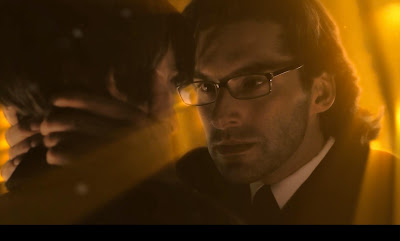 |
| LA Phil Music Director Gustavo Dudamel. |
Holler for Mahler, Mozart and more
By Ed Rampell
When it comes to L.A. Philharmonic's sprawling new season, it seems fitting to paraphrase Hamlet: “There are more things in heaven and earth, concertgoer, than are dreamt of in your philosophy.”
From a full stage production of Don Giovanni, all of Gustav Mahler's symphonies, the Piatigorsky Cello Festival and the world premiere of two operas, plus much more, the 2011/2012 season may be the L.A. Phil's greatest season ever.
Last night the season kicked off at the world-renowned Walt Disney Concert Hall in downtown Los Angeles with a trio of jazzy George Gershwin classics -- Rhapsody in Blue, An American in Paris and Cuban Overture. Legendary multiple-Grammy Award winning composer and the L.A. Philharmonic's Creative Chair for Jazz Herbie Hancock tickled the ivories under the able baton of that 30-year-old wunderkind, Gustavo Dudamel, who returns for his third season as L.A. Phil’s Music Director.
The WDCH 2011/2012 season highlights include:
A special Halloween screening on Oct. 30 of a German Expressionist masterpiece and trendsetting horror movie, the 1919 silent film, The Cabinet of Dr. Caligari, accompanied by a live, improvised soundtrack performed by organist Clark Wilson, who has scored many silent pictures, including Fritz Lang’s Metropolis. Nicknamed "The French Fries," the Walt Disney Concert Hall organ has 6,134 pipes that range in size from 800 pounds, 32' to a quarter inch long; 61-note manual keyboards; and 32-note pedal boards...it’s enough to wake a murderous, hypnotized somnambulist up!
After offering his signature Beethoven, plus a world premiere composed by Anders Hillborg, in late November, in early December former L.A. Phil Music Director Esa-Pekka Salonen will conduct the world premiere of the late Soviet composer Dmitri Shostakovich’s opera, Orango. Reportedly the story about the corporate media and a human-ape creature, Orango is directed by Peter Sellars, who previously collaborated with John Adams on topical operas, such as Nixon in China and The Death of Klinghoffer.
In celebration of Mahler's 150th birthday anniversary, from Jan. 13 to Feb. 5 “The Mahler Project” -- featuring all of Mahler’s 10 symphonies, plus other works by the Austrian composer – will be performed by the Los Angeles Philharmonic and the Simón Bolívar Symphony Orchestra of Venezuela. The series kicks off with Mahler’s Symphony No. 4 and his Songs of a Wayfarer, with Dudamel conducting baritone Thomas Hampson and soprano Miah Persson. From there you can get all the Mahler your ears desire (or finances can afford) at what many consider the world's greatest acoustic venue. However, please note that due to the size of production, the Mahler Project’s crown jewel takes place Feb. 4 at L.A.’s Shrine Auditorium, where the Simón Bolívar Symphony Orchestra and L.A. Phil team up, literally, with hundreds of singers to present Mahler’s much vaunted Symphony No. 8, "Symphony of a Thousand." This massive effort to perform all of Mahler's symphonies in such a short time may very well be one of the greatest feats in Los Angeles' musical history. It will certainly be one of Dudamel's defining career efforts.
April 5-7 L.A. Philharmonic Creative Chair John Adams conducts the West Coast premiere of minimalist composer Philip Glass’ Symphony No. 9, which the L.A. Phil co-commissioned.
If hearing Glass sounds like something crystal cool, crystal cool, crystal cool, just wait until May when Dudamel conducts Wolfgang Amadeus Mozart’s immortal opera, Don Giovanni, with set designs by none other than Frank Gehry, the imaginative architect who created the Disney Concert Hall’s wavy gravy design. These are already the hottest tickets of the season.
Finally L.A. Phil’s 2011/2012 season closes with a bang: Dudamel will conduct the world premiere of Adams’ vocal work, The Gospel According to the Other Mary, which will run May 31-June 3. In what might be described as Gabriel Garcia Marquez meets the Bible, The Gospel According to the Other Mary mixes New Testament Stories, Latin poetry and a combination of other materials, creating a magical realist take on social justice.
Throughout L.A. Phil’s eclectic season works by Hector Berlioz, Felix Mendelssohn, Franz Schubert, Jean Sibelius, Edvard Grieg, John Cage, Billie Holiday, etc., will also be played, as will holiday favorites, such as Handel’s Messiah. World renowned pianist Lang Lang, violinist Joshua Bell, guitarist Paco de Lucia, the greatly influential Steve Reich, singer-songwriter Judy Collins and Broadway crooner Elaine Stritch in a rare (and what may be her last) West Coast appearance, are among the solo artists who are also scheduled to take the Disney Concert Hall’s stage during this season’s hectic cavalcade of sound fury – and fun.
The Boston Symphony Orchestra, Seoul Philharmonic and New York Philharmonic will also perform at WDCH this season.
Lastly, if this sounds great to you, you may want to order your subscription(s) through one of the LA Phil's best kept secrets, Walt Disney Concert Hall's Priority Seating Office. Catering to exclusive patrons, the office can offer you priority seating, free ticket exchange, free ticket replacements, a money back guarantee, free parking, free comp tickets, no taxes and a slew of other benefits not offered anywhere else. You can contact the office at the unpublished number, 323-850-2049. If you are polite and act like you are in the know when you ask for your "representative," they will most likely hook you up (mornings are better).
For more information see: www.laphil.com.








